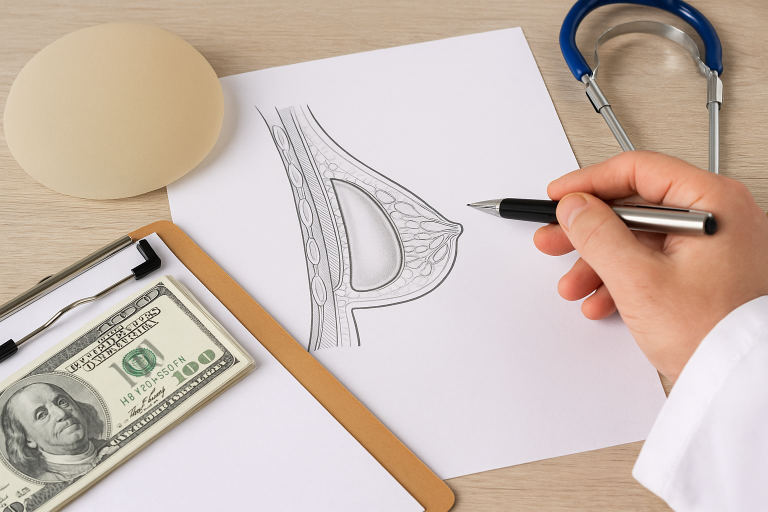Getting Mia® Implants? Proper aftercare is key for the best results! Do: Follow your doctor’s instructions, stay hydrated, and avoid heavy activities. Don’t: Apply pressure on your breasts, sleep on your stomach, or skip follow-ups.
Recovery is quick, but gentle care ensures long-lasting results. Want a smooth healing process? Here’s a complete guide on the Do’s and Don’ts after Mia® Implants to help you recover safely!
Essential Aftercare for Mia® Breast Implants
Immediate Post-Surgery Care
After undergoing Mia® implant surgery, proper care during the initial recovery period is crucial for optimal healing and results. Patients should follow their surgeon’s instructions meticulously, including wearing the recommended post-surgical bra and taking prescribed medications as directed. It’s essential to keep the incision sites clean and dry to prevent infection.
Dr. Tarek emphasizes the importance of rest during this time, advising patients to avoid strenuous activities and to sleep in an elevated position to minimize swelling. Gentle arm movements are encouraged to maintain circulation, but patients should refrain from lifting their arms above shoulder level for the first few weeks.
Book A Consultation With Dr Tarek Bayazid
Installment Plan Available
- Keep incision sites clean and dry
- Wear the prescribed post-surgical bra
- Take medications as directed
- Rest and avoid strenuous activities
- Sleep in an elevated position
Wound Healing and Scar Management
Proper wound care is essential for minimizing scarring and promoting optimal healing. Patients should gently clean the incision sites as instructed by their surgeon, typically using mild soap and water. Applying silicone-based scar treatments, as recommended by the surgeon, can help improve the appearance of scars over time.
It’s crucial to protect the incision sites from direct sunlight and avoid submerging them in water (such as in baths or pools) until fully healed. Patients should monitor their incisions for any signs of infection, such as increased redness, warmth, or discharge.
- Clean incisions as directed
- Apply recommended scar treatments
- Protect incisions from sunlight and water
- Monitor for signs of infection
Pain Management and Medication
Managing discomfort after Mia® implant surgery is an important aspect of recovery. Patients should follow their surgeon’s pain management plan, which may include over-the-counter pain relievers or prescribed medications. It’s essential to take medications as directed and not exceed recommended dosages.
Applying cold compresses to the chest area can help reduce swelling and alleviate discomfort. However, patients should avoid applying ice directly to the skin and limit cold therapy sessions to 15-20 minutes at a time.
- Follow the prescribed pain management plan
- Take medications as directed
- Use cold compresses for swelling and discomfort
- Avoid direct ice application to the skin
Recovery Timeline for Mia® Implant Patients
First Week After Surgery
The initial week following Mia® implant surgery is crucial for healing. Patients should expect some discomfort, swelling, and bruising during this time. It’s essential to rest and avoid any activities that could strain the chest muscles or incision sites.
During this period, patients should focus on gentle movements, such as short walks around the house, to promote circulation and prevent blood clots. Maintaining proper hygiene and following wound care instructions are vital for preventing complications.
- Rest and avoid strenuous activities
- Take short walks to promote circulation
- Follow wound care instructions meticulously
- Attend follow-up appointments as scheduled
Weeks 2-6 Post-Operation
As recovery progresses, patients will gradually experience reduced swelling and increased comfort. During this phase, many patients can return to light daily activities and work, depending on their surgeon’s recommendations and the nature of their job.
It’s important to continue wearing the prescribed support bra and to avoid heavy lifting or intense physical activities. Patients should listen to their bodies and not push themselves too hard, as the healing process is still ongoing.
- Gradually increase light activities
- Continue wearing a support bra
- Avoid heavy lifting and intense exercise
- Attend follow-up appointments for progress evaluation
Long-Term Recovery and Results
By the 6-8 week mark, most patients have significantly recovered and can resume most normal activities. However, it’s important to note that the final results of Mia® implants may not be fully apparent for several months as the implants settle and the body adjusts.
Patients should continue to follow their surgeon’s long-term care instructions, including regular self-examinations and scheduled check-ups. It’s crucial to maintain a healthy lifestyle to support the longevity of the implants and overall breast health.
- Resume most normal activities after 6-8 weeks
- Be patient as final results develop over time
- Continue following long-term care instructions
- Maintain a healthy lifestyle for optimal results
Physical Activity Guidelines Following Mia® Implant Surgery
Resuming Daily Activities
Gradually returning to daily activities is an important part of the recovery process. Patients should start with light household tasks and slowly increase their activity level as comfort allows. It’s crucial to listen to your body and not push beyond your limits.
Dr. Tarek recommends starting with short walks and gentle arm movements to maintain flexibility. As recovery progresses, patients can gradually incorporate more activities into their routine, always being mindful of any discomfort or strain on the chest area.
- Start with light household tasks
- Take short walks to maintain mobility
- Gradually increase activity level as comfort allows
- Be mindful of any discomfort or strain
Exercise Restrictions and Recommendations
Exercise plays a vital role in overall health, but it’s important to approach physical activity cautiously after Mia® implant surgery. Patients should avoid high-impact exercises, heavy lifting, and activities that involve repetitive arm movements for at least 6-8 weeks post-surgery.
Low-impact exercises like walking can usually be resumed within a few weeks, while more strenuous activities should be gradually reintroduced under the guidance of your surgeon. It’s crucial to wear a supportive sports bra during exercise to minimize implant movement and discomfort.
- Avoid high-impact exercises for 6-8 weeks
- Start with low-impact activities like walking
- Gradually reintroduce more strenuous exercises
- Wear a supportive sports bra during physical activity
Sleeping Positions for Optimal Healing
Proper sleeping positions are crucial for comfort and optimal healing after Mia® implant surgery. Patients should sleep on their back with their upper body slightly elevated for the first few weeks. This position helps reduce swelling and minimizes pressure on the implants.
As recovery progresses, patients can gradually transition to sleeping on their side, using pillows for support. It’s important to avoid sleeping on the stomach for at least 8-12 weeks post-surgery to prevent unnecessary pressure on the implants and incision sites.
- Sleep on back with upper body elevated
- Use pillows for support when transitioning to side sleeping
- Avoid stomach sleeping for 8-12 weeks
- Adjust sleeping position gradually as comfort allows
Nutrition and Lifestyle Factors for Mia® Implant Recovery
Dietary Recommendations
A balanced diet rich in nutrients is essential for optimal healing after Mia® implant surgery. Patients should focus on consuming foods high in protein, vitamins, and minerals to support tissue repair and overall recovery. Lean meats, fish, fruits, vegetables, and whole grains are excellent choices.
It’s also important to stay hydrated by drinking plenty of water throughout the day. Some patients may find it helpful to eat smaller, more frequent meals to avoid discomfort from a full stomach pressing against the chest area.
- Consume a balanced diet rich in protein and nutrients
- Focus on lean meats, fish, fruits, vegetables, and whole grains
- Stay hydrated with plenty of water
- Consider eating smaller, more frequent meals
Smoking and Alcohol Consumption
Smoking and alcohol consumption can significantly impair the healing process and increase the risk of complications after Mia® implant surgery. Patients are strongly advised to quit smoking at least 4-6 weeks before surgery and to continue abstaining throughout the recovery period.
Alcohol should also be avoided for at least 2-3 weeks post-surgery, as it can interact with medications and increase the risk of bleeding. After this initial period, patients should consult their surgeon before reintroducing alcohol into their diet.
- Quit smoking at least 4-6 weeks before surgery
- Continue abstaining from smoking throughout recovery
- Avoid alcohol for 2-3 weeks post-surgery
- Consult with the surgeon before reintroducing alcohol
Hydration and Skin Care
Proper hydration is crucial for overall health and can aid in the healing process after Mia® implant surgery. Patients should aim to drink at least 8-10 glasses of water per day to support tissue repair and maintain skin elasticity.
Gentle skin care is important for the incision sites and surrounding areas. Patients should follow their surgeon’s instructions for cleansing and moisturizing the skin, avoiding harsh products or excessive rubbing. Sun protection is essential, especially for the incision sites, to prevent hyperpigmentation and promote optimal scar healing.
- Drink 8-10 glasses of water daily
- Follow the surgeon’s instructions for skin care
- Use gentle, non-irritating products
- Protect incision sites from sun exposure
Follow-Up Appointments and Monitoring Mia® Implants
Importance of Regular Check-ups
Regular follow-up appointments are crucial for monitoring the healing process and ensuring the best possible outcomes after Mia® implant surgery. These check-ups allow the surgeon to assess the implants’ position, evaluate healing progress, and address any concerns or complications promptly.
Patients should attend all scheduled appointments and be prepared to discuss any changes or concerns they’ve noticed since their last visit. These appointments also provide an opportunity to ask questions about long-term care and maintenance of the implants.
- Attend all scheduled follow-up appointments
- Discuss any changes or concerns with the surgeon
- Ask questions about long-term care and maintenance
- Follow the recommended check-up schedule
Signs of Complications to Watch For
While complications are rare with Mia® implants, it’s important for patients to be aware of potential warning signs. Unusual pain, swelling, redness, or warmth in the breast area could indicate an infection or other complication. Changes in breast shape, size, or implant position should also be reported to the surgeon immediately.
Patients should also be alert for any signs of implant rupture, such as sudden changes in breast size or shape, increased pain or tenderness, or lumps in the breast. Any concerns should be promptly discussed with the surgeon to ensure timely intervention if necessary.
- Monitor for unusual pain, swelling, redness, or warmth
- Report changes in breast shape, size, or implant position
- Be alert for signs of implant rupture
- Seek medical attention for any concerning symptoms
Long-Term Implant Maintenance
Long-term maintenance of Mia® implants involves regular self-examinations and following the surgeon’s recommendations for periodic imaging studies. Patients should become familiar with the normal look and feel of their breasts post-surgery to more easily detect any changes.
Routine mammograms or other imaging studies may be recommended to monitor the implants’ integrity over time. Patients should inform their healthcare providers about their implants when undergoing any breast imaging or medical procedures.
- Perform regular self-examinations
- Follow recommendations for periodic imaging studies
- Familiarize yourself with the normal look and feel of your breasts
- Inform healthcare providers about your implants
Post Mia® Implant Surgery Clothing and Bra Recommendations
Choosing the Right Support Garments
Proper support is crucial for comfort and optimal healing after Mia® implant surgery. Patients should wear the prescribed post-surgical bra or compression garment as directed by their surgeon. These garments help reduce swelling, provide support, and minimize implant movement during the initial recovery period.
As healing progresses, patients can transition to soft, supportive bras without underwiring. Sports bras or front-closure bras may be more comfortable and easier to put on during the early stages of recovery. It’s important to avoid bras that put pressure on the incision sites or cause discomfort.
- Wear a prescribed post-surgical bra or compression garment
- Transition to soft, supportive bras without underwire
- Consider sports bras or front-closure bras for comfort
- Avoid bras that pressure incision sites or cause discomfort
Final Thoughts
Proper aftercare is key to a smooth recovery after Mia® implant surgery. Follow your surgeon’s instructions, prioritize wound care, manage pain, and ease back into activities. Stay hydrated, eat well, and attend regular check-ups to ensure long-lasting results.
FAQs
How long do Mia® implants typically last?
Mia® implants are designed to provide long-lasting results for up to 10 years. However, as with any implant, individual experiences may vary, and regular check-ups with your healthcare provider are essential to monitor their condition over time.
What happens if a Mia® implant ruptures?
General implant complications can include changes in breast shape or size, lumps, pain, or swelling. If you suspect a rupture, consult your surgeon promptly for evaluation and potential treatment options.
How often should I get my Mia® implants checked?
Regular monitoring is essential to ensure the implants remain in good condition. Consult your healthcare provider for personalized recommendations on the frequency of check-ups.
Can I breastfeed with Mia® implants?
Many women can successfully breastfeed after breast augmentation procedures, including those with implants. However, individual experiences may vary. Discuss your breastfeeding plans with your surgeon prior to the procedure to understand any potential impacts.
How long does it take to recover from Mia® implant surgery?
The Mia® procedure is minimally invasive, typically allowing patients to resume daily activities shortly after the procedure. However, it’s important to follow your surgeon’s post-operative care instructions for optimal healing.
Can I sleep on my side after Mia® implant surgery?
Post-operative sleeping positions should be discussed with your surgeon. While some patients may be advised to sleep on their backs initially, individual recommendations may vary.
When can I resume exercise after getting Mia® implants?
Patients are generally advised to refrain from strenuous exercise for a period following the procedure. Consult your surgeon for personalized advice on when to safely resume physical activities








